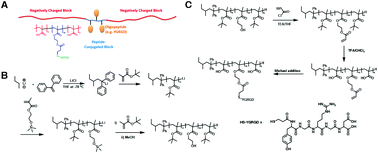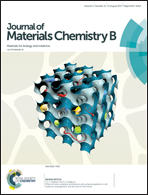Manipulation of cell adhesion and dynamics using RGD functionalized polymers
Abstract
We have successfully synthesized an ABA tri-block co-polymer of poly(methacrylic acid)-block-poly(2-hydroxyethyl methacrylate)-block-poly(methacrylic acid), having Mw = 100k and 272k where we were able to insert RDG or RGD peptide sequences using thiol-acrylate Michael addition. A soft silicone stamp was then used to imprint a 0.4-micron wide grating of the copolymer with a period of 10 microns. The samples were then examined with atomic force microscopy after application of an external electric field and the pattern was observed to stretch by a factor of five. Cells plated onto these substrates showed clear preference for the striped patterns formed under the influence of the external field, and no preferential attachment to the patterns formed in the absence of the field. Cell migration experiments, using the agarose droplet method, performed on spun cast copolymer films showed minimal migration and adhesion on the substrates without peptides or those with only with the RDG peptide, while good adhesion and significant outward migration was observed for cells plated on the copolymers with the RGD sequence. Taken together these results confirmed our hypothesis that a smart biomimetic polymer substrate could be constructed where functional domains could be revealed selectively allowing us to mimic the natural design of engineered tissue constructs.



 Please wait while we load your content...
Please wait while we load your content...